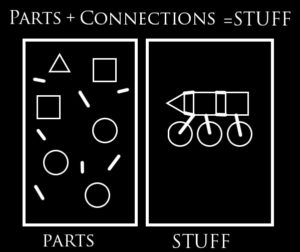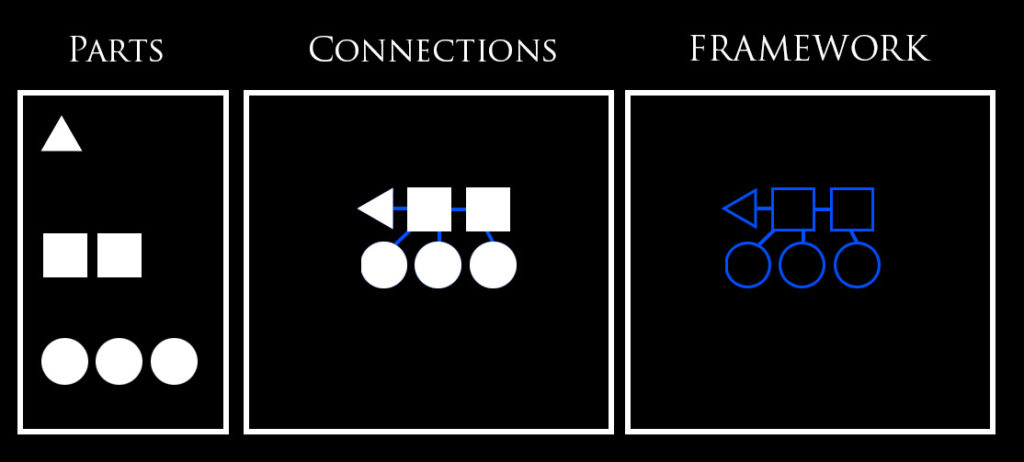There’s a concept in there that’s important to understand as a fundamental feature of development that can be a bit elusive that I want to take a moment to clarify. framework.
What is a framework… two key things
it describes the relationship/connections between parts that make up a thing. – it’s the essence and nature of their complexity. It’s their plan, whether theoretical or realized in the form of an actual thing.
It’s developable. Therefore it exists! It’s stable enough to be articulated in terms of parts and connections that can persist through time and be subject to the effects of change.
A framework is basically the difference between a pile of parts and a functional whole. Here is a very basic visual framework for thinking about parts and connections…

I call this the diptych. When I think about something that’s complex that I want to understand and perhaps improve, I think about it this way… this is the form my mental model takes… a parts list on the left… what are all the pieces? and it’s connected whole on the right… how do all the pieces fit together?
These are the same thing. The same parts. Not the same whole.


The framework is the difference between the left and right sides of the diptych. It’s kind of a blueprint of connections that’s the difference between a functional whole and a pile of parts. It’s the mysterious organizing field that can persist even if all the parts are taken away. The framework is the thing that actually evolves through development.
Don dellilo passage on Parts of a shoe… The mysterious quotidian. Same for Parts of a process – they’re in front of you all the time, but hard to understand and talk about when you don’t know what you’re looking at. You can’t diagnose problems, you can’t evolve if you don’t know the anatomy of your process. You need to know the anatomy of your process.
Technically, all the parts of everything that exists today and everything that will ever exist have existed since the moment of the Big Bang. But the frameworks, the complex organization of those parts, haven’t always existed or haven’t yet been realized. The frameworks that have evolved over billions of years have organized the very same parts that first differentiated themselves as part of the big bang into the reality we know. And, as the sentient, resourceful beings we are, we have the capacity and the opportunity to evolve them from our current circumstances through collaborative development into a variety of different realities that we can envision and build toward in the future.

We see in nature that evolution builds frameworks in the form of complex organisms. And that humans also build these things in a number of different ways. Physical things… mechanical things, but also frameworks in the form of theories. Taking the parts of observable phenomenon and building mental models that account for and connect all the visible pieces together. The different branches of science collectively take account of and codify the parts and connections of everything observable in the universe in their particular fields of study and express those models as theoretical frameworks.
To understand what I mean by framework, here are some examples. You may be familiar with Plutarch’s “Paradox of Theseus’ ship” sometimes recast as “my grandfathers’ axe”
My grandfather passed his axe to my father who, when the axehead broke, replaced it with a new axehead. My father passed the axe to me who, when the haft broke, replaced it with a new haft. Is it still my grandfather’s axe?
Although the eponymous grandfather’s hands never touched any of its current parts, the framework has persisted and connects the axe of today directly through time with the grandfather’s.

Most people are familiar with the idea that slowly over time your cells are dying and being regrown… and that in the span of seven years, every cell in your body is replaced. While that’s not actually true of your entire body (neurons aren’t replaced), it’s true of the other cells, parts, of the body. Your body would be nothing without your parts, sure… but it’s also not just your parts… there’s another dimension to your body that persists beyond them in time and through time. Its framework.
To illustrate the point in the context of another organism, a company…
The oldest company in the world, according to the Guinness Book of World Records is in Yamanashi, Japan: a hot-spring hotel called Nisiyama Onsen Keiunkan, which has existed since the year 705.

More familiar companies… Jim Beam, State Street, Cigna… these companies are each more than two hundred years old. The human parts of these companies have turned over completely at least a few times. There’s not a single person in these institutions today that was there when they started. But they’re the same institutions. The framework, even though it has itself evolved, is persistent through time.
How do you make a vision into a reality? The first step is materializing your vision into a resource in some way… to make your vision into an iteration… a first, legible, developable framework. What’s a vision? The product of your uniquely human capacity to see outward and upward what is not already there. It could be anything. If you’re an artist, it might be the idea for a painting. Close your eyes and imagine a painting. The most beautiful painting the world has ever seen. The color and light are magnificent, the gesture perfectly stated, the presentation profoundly moving. Really try to see it in your mind’s eye. Let yourself zoom in and glide over the details… see how it’s lit. See the texture of the brushstrokes. Hold the whole composition in your imagination. That’s a vision. It’s yours. It could be reality, but it’s trapped in your head. How do you get it out? Describing it in words is a start… but the resolution of words can barely capture or convey the visual nuance of it. It’s like trying to describe a complex, personal dream. It just can’t be shared with words. But they’re a start. Trying to put it into words creates a first resource that can be used to develop. A better first step might be a rough drawing. Using a more appropriate visual language to capture a visual vision. What’s called a thumbnail in the realm of concept art, the purpose of which is quite literally to take a vision and turn it into a resource.
The most important idea to understand about Framework for this model is that, whether recognized or not, it is the basis for and subject of development. Everything must have a framework to develop. That is a fundamental rule. Ideas to be developed need to be adapted to legible expressions of parts and their connections in an articulable framework, even if initially they’re only theories. You cant go through meaningful cycle and selection process without a framework to start from.
